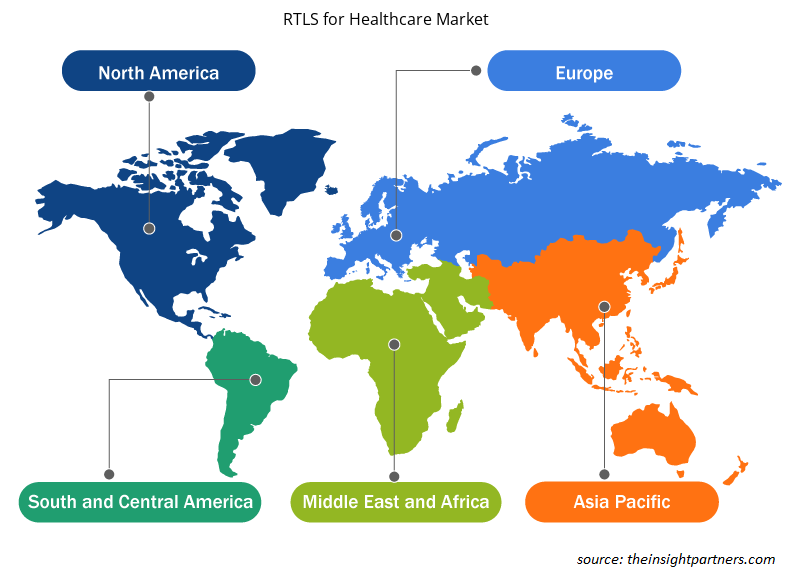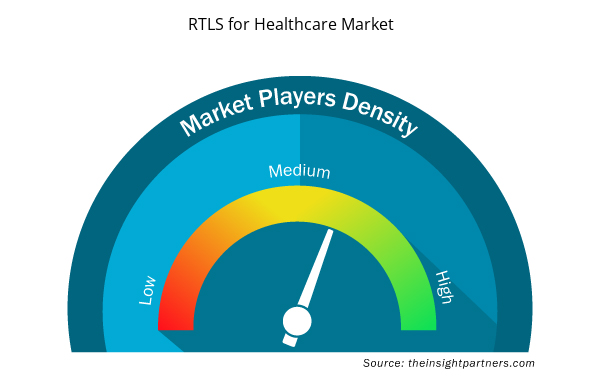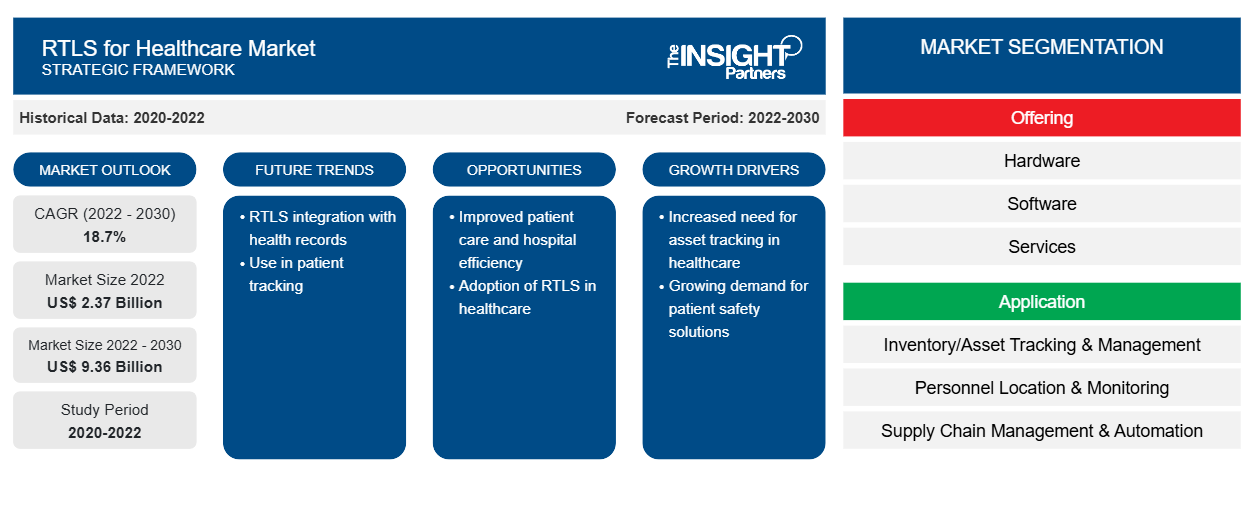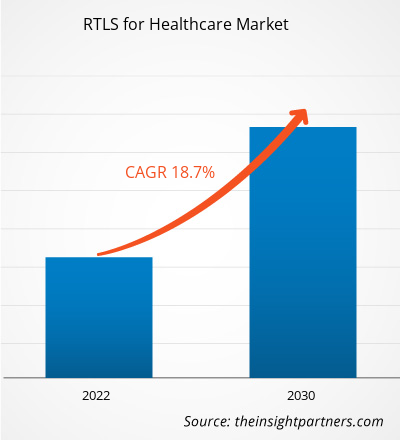[研究报告] 2022 年医疗保健 RTLS 市场价值为 23.7 亿美元,预计到 2030 年将达到 93.6 亿美元。预计 2022-2030 年的复合年增长率为 18.7%。
市场洞察和分析师观点:
医疗保健领域的实时定位服务 (RTLS) 用于实时跟踪和管理各类医疗机构中的员工、医疗设备和患者。医院、老年生活设施、门诊中心和诊断实验室等医疗机构正在使用 RTLS 来跟踪医疗设备、患者、医疗专业人员和报告。例如,老年生活设施使用通过 RTLS 连接的标签和徽章来跟踪主要患有阿尔茨海默病或患有记忆丧失的老年人口。人们越来越意识到 RTLS 在员工管理方面的优势以及在减少资本支出的情况下获得高投资回报,这推动了医疗保健市场规模的 RTLS 增长。
增长动力和挑战:
医疗保健专业人员的短缺和实时定位系统 (RTLS) 使用的增加是推动医疗保健实时定位系统 (RTLS) 市场增长的因素之一。全球医疗保健专业人员数量严重短缺。2020 年,世界卫生组织 (WHO) 发布的第一份《世界护理状况报告》(SOWN) 指出,全球护理人员为 2790 万人,预计到 2030 年全球护士短缺 590 万人。根据美国医学院协会 (AAMC) 的数据,预计到 2030 年美国将面临约 12 万名医生的短缺,影响全国的整体患者护理。西门子发表的一篇文章称,护士每班花费大约 72 分钟寻找设备,平均设备利用率低于 40%,而在没有实时定位服务 (RTLS) 的设施中,丢失或被盗资产的比例估计约为 10%。由于人员短缺,寻找设备对护士来说变成了一项不必要的任务。因此,为了管理可用人员的时间,医疗机构正致力于安装 RTLS 系统,通过该系统他们可以轻松找到所需的设备或人员。因此,由于医疗专业人员的短缺,医疗机构已开始使用 RTLS 技术来管理其机构中的工作流程。
预计在未来几年,在家庭医疗保健过程中使用 RTLS 技术实现适当的连接将为医疗保健市场带来新的 RTLS 趋势。
定制此报告以满足您的需求
您可以免费定制任何报告,包括本报告的部分内容、国家级分析、Excel 数据包,以及为初创企业和大学提供优惠和折扣
- 获取此报告的关键市场趋势。这个免费样品将包括数据分析,从市场趋势到估计和预测。
报告细分和范围:
医疗保健 RTLS 市场分析考虑了以下几个部分:产品、技术、应用、设施类型和地理位置。根据产品,市场分为硬件、软件和服务。硬件部分进一步细分为读取器/跟踪器/接入点、标签/徽章和其他硬件。服务部分进一步分为咨询、部署和集成以及支持和维护。根据应用,市场分为库存/资产跟踪和管理、人员定位和监控、供应链管理和自动化等。
从技术角度来看,市场分为 Wi-Fi、RFID 和其他。从设施类型来看,市场分为医院和医疗保健设施以及老年生活设施。从地理上看,医疗保健实时定位系统市场主要分为北美(美国、加拿大和墨西哥)、欧洲(西班牙、英国、德国、法国、意大利和欧洲其他地区)、亚太地区(韩国、中国、印度、日本、澳大利亚和亚太其他地区)、中东和非洲(南非、沙特阿拉伯、阿联酋和中东和非洲其他地区)以及南美洲和中美洲(巴西、阿根廷和南美洲和中美洲其他地区)。
节段分析:
医疗保健 RTLS 市场按产品细分为硬件、软件和服务。硬件进一步细分为读取器/跟踪器/接入点、标签/徽章和其他硬件。2022 年,软件和服务部门占据了最大的市场份额,预计在 2022-2030 年期间将录得最高复合年增长率。软件和服务部门的增长是由公司推出的软件产品推动的,这些产品旨在提高RTLS 系统的效率。例如,2021 年 6 月,Midmark RTLS 推出了一款基于云的低功耗蓝牙 (BLE) 资产跟踪解决方案,该解决方案使资产跟踪功能现代化。
根据应用,市场分为库存/资产跟踪和管理、人员定位和监控、供应链管理和自动化等。2022 年,库存/资产跟踪和管理领域占据医疗保健实时定位系统的最大市场份额。预计人员定位和监控领域将在 2022-2030 年期间录得最高复合年增长率。
根据技术,医疗保健 RTLS 市场细分为 Wi-Fi、射频识别 (RFID)等。2022 年,RFID 领域占据了最大的市场份额,预计在 2022-2030 年期间将录得最高复合年增长率。
根据设施类型,市场分为医院和医疗保健设施以及老年生活设施。2022 年,医院和诊所部门在医疗保健实时定位系统市场中占有较大的份额,预计在 2022-2030 年期间将录得更高的复合年增长率。
区域分析:
医疗保健 RTLS 市场报告的范围主要集中在北美、欧洲、亚太地区、中东和非洲以及南美和中美洲。预计亚太地区在 2022-2030 年期间的市场复合年增长率最高。由于技术先进的医院数量不断增加、RTLS 在老年生活设施和家庭护理中的使用日益增多,以及参与新产品和现有产品开发的关键市场参与者的存在,北美在 2022 年占据了全球市场的最大份额。北美是医疗保健 RTLS 市场增长的最大贡献者。在北美,美国在 2022 年占据了最大的市场份额。
行业发展和未来机遇:
医疗保健 RTLS 市场预测是根据各种二手和一手研究结果(如主要公司出版物、协会数据和数据库)估算的。以下列出了医疗保健 RTLS 市场中主要参与者的一些计划:
- 2022 年 4 月,Cognosos 推出了一款名为主动定期自动补货 (ProPAR) 的新医疗设备软件套件。ProPAR 是 RTLS 仪表板和解决方案的数字版本,通过提供对医疗机构中资产数量和 PAR 水平阈值的即时可见性,为中央供应和生物医学工程团队提供支持。ProPAR 利用 Cognosos 的室内 RTLS 定位引擎解决方案 LocationAI,该解决方案提供房间级别的设备位置可见性,无需搜索设备进行清洁或再循环、维护,并有助于确保始终满足 PAR 水平。
- 2020 年 7 月,研华推出了 RTLS 解决方案就绪包 (SRP),旨在实时定位和监控医疗设备、工作人员和患者。研华的 RTLS SRP 是一种硬件软件解决方案,包括位置传感器、边缘服务器、标签、医疗级平板电脑、仪表板和 RTLS 管理软件。研华的多模传感动态融合 (MSDF) 技术与 RTLS SRP 的集成可减少障碍物的干扰并提高复杂室内环境中的定位性能。
医疗保健 RTLS 市场区域洞察
Insight Partners 的分析师已详细解释了预测期内影响医疗保健实时定位系统市场的区域趋势和因素。本节还讨论了北美、欧洲、亚太地区、中东和非洲以及南美和中美洲的医疗保健实时定位系统市场细分和地理位置。

- 获取医疗保健市场 RTLS 的区域特定数据
医疗保健实时定位系统市场报告范围
| 报告属性 | 细节 |
|---|---|
| 2022 年市场规模 | 23.7亿美元 |
| 2030 年市场规模 | 93.6亿美元 |
| 全球复合年增长率(2022 - 2030 年) | 18.7% |
| 史料 | 2020-2022 |
| 预测期 | 2022-2030 |
| 涵盖的领域 | 通过奉献
|
| 覆盖地区和国家 | 北美
|
| 市场领导者和主要公司简介 |
|
市场参与者密度:了解其对商业动态的影响
医疗保健市场实时定位系统 (RTLS) 市场正在快速增长,这得益于终端用户需求的不断增长,这些需求源于消费者偏好的不断变化、技术进步以及对产品优势的认识不断提高等因素。随着需求的增加,企业正在扩大其产品范围,进行创新以满足消费者需求,并利用新兴趋势,从而进一步推动市场增长。
市场参与者密度是指在特定市场或行业内运营的企业或公司的分布情况。它表明在给定市场空间中,相对于其规模或总市场价值,有多少竞争对手(市场参与者)存在。
在医疗保健 RTLS 市场运营的主要公司有:
- CenTrak 公司
- 研华
- 证券医疗保健有限责任公司
- 斑马技术
- Aruba 网络
免责声明:上面列出的公司没有按照任何特定顺序排列。

- 获取医疗保健市场 RTLS 顶级关键参与者概述
竞争格局和重点公司:
CenTrak Inc、Advantech、Securitas Healthcare LLC、Zebra Technologies、Aruba Networks、GE Healthcare、Ubisense、TeleTracking Technologies、Siemens Healthcare Pvt Ltd 和 HID Global Corporation 是医疗保健实时定位系统市场报告中介绍的知名企业。此外,研究还研究和分析了其他几家企业,以全面了解市场及其生态系统。这些公司专注于地域扩张和新产品发布,以满足全球消费者日益增长的需求,并增加其专业产品组合的产品范围。他们的全球业务使他们能够服务于庞大的客户群,从而促进市场扩张。
- 历史分析(2 年)、基准年、预测(7 年)及复合年增长率
- PEST 和 SWOT 分析
- 市场规模价值/数量 - 全球、区域、国家
- 行业和竞争格局
- Excel 数据集



Report Coverage
Revenue forecast, Company Analysis, Industry landscape, Growth factors, and Trends

Segment Covered
This text is related
to segments covered.

Regional Scope
North America, Europe, Asia Pacific, Middle East & Africa, South & Central America

Country Scope
This text is related
to country scope.
常见问题
The RTLS for healthcare market, by offering, is segmented into hardware, and software & services. Hardware is further segmented into readers/trackers/access points, tags/badges, and other hardware. In 2022, the software & services segment held the largest share of the market and is expected to record the highest CAGR during 2022–2030. The software & services segment growth is driven by software product launches by companies to improve the efficiency of RTLS systems. For instance, in June 2021, Midmark RTLS launched a cloud-based, Bluetooth Low Energy (BLE) asset tracking solution, which modernizes asset tracking capabilities.
Based on application, the market is divided into inventory/asset tracking & management, personnel locating & monitoring, supply chain management & automation, and others. In 2022, the inventory/asset tracking & management segment held the largest RTLS for healthcare market share. The personnel locating & monitoring segment is expected to record the highest CAGR during 2022–2030.
Based on technology, the RTLS for healthcare market is segmented into Wi-Fi, Radio-Frequency Identification (RFID), and others. In 2022, the RFID segment held the largest share of the market and is expected to record the highest CAGR during 2022–2030.
The market, by facility type, is segmented into hospital and healthcare facilities, and senior living facilities. In 2022, the hospitals and clinics segment held a larger RTLS for healthcare market share and is expected to record a higher CAGR during 2022–2030.
Based on geography, the RTLS for healthcare market is segmented into North America (the US, Canada, and Mexico), Europe (the UK, Germany, France, Italy, Spain, and the Rest of Europe), Asia Pacific (China, Japan, India, South Korea, Australia, and the Rest of Asia Pacific), the Middle East & Africa (the UAE, Saudi Arabia, South Africa, and Rest of the Middle East & Africa), and South & Central America (Brazil, Argentina, and the Rest of South & Central America). North America is the largest contributor to the growth of the global RTLS for healthcare market. Asia Pacific is expected to register the highest CAGR in the RTLS for healthcare market during 2022–2030.
Real-time location services (RTLS) in healthcare are used to provide real-time tracking as well as management of staff, medical equipment, and patients in all types of healthcare facilities. Healthcare facilities such as hospitals, senior living facilities, ambulatory centers, and diagnostic laboratories are using RTLS to track medical equipment, patients, healthcare professionals, and reports. For instance, senior living facilities uses tags and badges connected through RTLS to track the geriatric population majorly suffering from Alzheimer’s disease or who suffer from memory loss. Increasing awareness about the advantages of RTLS for staff management and high return on investment with reduced capital expenditure propels the RTLS for healthcare market growth size.
Increasing awareness about the advantages of RTLS for staff management and high return on investment with reduced capital expenditure propel the RTLS for healthcare market growth. However, data security and privacy issues hinder the growth of the market.
The RTLS for healthcare market majorly consists of the players such CenTrak Inc, Advantech, Securitas Healthcare LLC, Zebra Technologies, Aruba Networks, GE Healthcare, Ubisense, TeleTracking Technologies, Siemens Healthcare Pvt Ltd, and HID Global Corporation.
Trends and growth analysis reports related to Technology, Media and Telecommunications : READ MORE..
The List of Companies - RTLS for Healthcare Market
- CenTrak Inc
- Advantech
- Securitas Healthcare LLC
- Zebra Technologies
- Aruba Networks
- GE Healthcare
- Ubisense
- TeleTracking Technologies
- Siemens Healthcare Pvt Ltd
- HID Global Corporation
The Insight Partners performs research in 4 major stages: Data Collection & Secondary Research, Primary Research, Data Analysis and Data Triangulation & Final Review.
- Data Collection and Secondary Research:
As a market research and consulting firm operating from a decade, we have published and advised several client across the globe. First step for any study will start with an assessment of currently available data and insights from existing reports. Further, historical and current market information is collected from Investor Presentations, Annual Reports, SEC Filings, etc., and other information related to company’s performance and market positioning are gathered from Paid Databases (Factiva, Hoovers, and Reuters) and various other publications available in public domain.
Several associations trade associates, technical forums, institutes, societies and organization are accessed to gain technical as well as market related insights through their publications such as research papers, blogs and press releases related to the studies are referred to get cues about the market. Further, white papers, journals, magazines, and other news articles published in last 3 years are scrutinized and analyzed to understand the current market trends.
- Primary Research:
The primarily interview analysis comprise of data obtained from industry participants interview and answers to survey questions gathered by in-house primary team.
For primary research, interviews are conducted with industry experts/CEOs/Marketing Managers/VPs/Subject Matter Experts from both demand and supply side to get a 360-degree view of the market. The primary team conducts several interviews based on the complexity of the markets to understand the various market trends and dynamics which makes research more credible and precise.
A typical research interview fulfils the following functions:
- Provides first-hand information on the market size, market trends, growth trends, competitive landscape, and outlook
- Validates and strengthens in-house secondary research findings
- Develops the analysis team’s expertise and market understanding
Primary research involves email interactions and telephone interviews for each market, category, segment, and sub-segment across geographies. The participants who typically take part in such a process include, but are not limited to:
- Industry participants: VPs, business development managers, market intelligence managers and national sales managers
- Outside experts: Valuation experts, research analysts and key opinion leaders specializing in the electronics and semiconductor industry.
Below is the breakup of our primary respondents by company, designation, and region:

Once we receive the confirmation from primary research sources or primary respondents, we finalize the base year market estimation and forecast the data as per the macroeconomic and microeconomic factors assessed during data collection.
- Data Analysis:
Once data is validated through both secondary as well as primary respondents, we finalize the market estimations by hypothesis formulation and factor analysis at regional and country level.
- Macro-Economic Factor Analysis:
We analyse macroeconomic indicators such the gross domestic product (GDP), increase in the demand for goods and services across industries, technological advancement, regional economic growth, governmental policies, the influence of COVID-19, PEST analysis, and other aspects. This analysis aids in setting benchmarks for various nations/regions and approximating market splits. Additionally, the general trend of the aforementioned components aid in determining the market's development possibilities.
- Country Level Data:
Various factors that are especially aligned to the country are taken into account to determine the market size for a certain area and country, including the presence of vendors, such as headquarters and offices, the country's GDP, demand patterns, and industry growth. To comprehend the market dynamics for the nation, a number of growth variables, inhibitors, application areas, and current market trends are researched. The aforementioned elements aid in determining the country's overall market's growth potential.
- Company Profile:
The “Table of Contents” is formulated by listing and analyzing more than 25 - 30 companies operating in the market ecosystem across geographies. However, we profile only 10 companies as a standard practice in our syndicate reports. These 10 companies comprise leading, emerging, and regional players. Nonetheless, our analysis is not restricted to the 10 listed companies, we also analyze other companies present in the market to develop a holistic view and understand the prevailing trends. The “Company Profiles” section in the report covers key facts, business description, products & services, financial information, SWOT analysis, and key developments. The financial information presented is extracted from the annual reports and official documents of the publicly listed companies. Upon collecting the information for the sections of respective companies, we verify them via various primary sources and then compile the data in respective company profiles. The company level information helps us in deriving the base number as well as in forecasting the market size.
- Developing Base Number:
Aggregation of sales statistics (2020-2022) and macro-economic factor, and other secondary and primary research insights are utilized to arrive at base number and related market shares for 2022. The data gaps are identified in this step and relevant market data is analyzed, collected from paid primary interviews or databases. On finalizing the base year market size, forecasts are developed on the basis of macro-economic, industry and market growth factors and company level analysis.
- Data Triangulation and Final Review:
The market findings and base year market size calculations are validated from supply as well as demand side. Demand side validations are based on macro-economic factor analysis and benchmarks for respective regions and countries. In case of supply side validations, revenues of major companies are estimated (in case not available) based on industry benchmark, approximate number of employees, product portfolio, and primary interviews revenues are gathered. Further revenue from target product/service segment is assessed to avoid overshooting of market statistics. In case of heavy deviations between supply and demand side values, all thes steps are repeated to achieve synchronization.
We follow an iterative model, wherein we share our research findings with Subject Matter Experts (SME’s) and Key Opinion Leaders (KOLs) until consensus view of the market is not formulated – this model negates any drastic deviation in the opinions of experts. Only validated and universally acceptable research findings are quoted in our reports.
We have important check points that we use to validate our research findings – which we call – data triangulation, where we validate the information, we generate from secondary sources with primary interviews and then we re-validate with our internal data bases and Subject matter experts. This comprehensive model enables us to deliver high quality, reliable data in shortest possible time.


 获取此报告的免费样本
获取此报告的免费样本